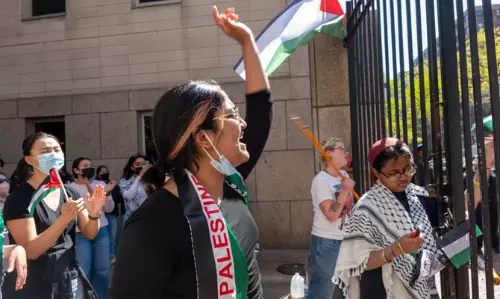
Hindus prayed facing the mosque: SC observes in Babri Masjid title case
text_fieldsNew Delhi: The Supreme Court bench which is hearing the arguments in Babri Masjid title case, made an important observation when it said that since 1855 Hindus might have prayed facing the main dome, of the mosque, which they believed as Ram Janmabhumi. The lawyer of Sunni Waqf Board Advocate Rajeev Dhavan questioned the observation, made by Justice D.Y. Chandrachud of the five-member bench, as none of the Hindu parties have raised such an argument till the 26th day of the hearing. Dhavan criticised that Justice Chandrachud has added points that did not figure in Babri Masjid title case so far.
Justice Ashok Bhushan also supported Justice Chandrachud as he stood firm in his opinion. Justice Chandrachud opined that it was strange that Ramchabutra came into foray after fixing a fence following an armed violence between the Hindus and the Muslims. Till then the Muslims and the Hindus used to enter the mosque, the judge added. After the incident, the Muslims prayed inside the mosque and the Hindus prayed in Ramchabhutra, which is 50 yards away from the main dome of the mosque.
Ramchabhutra was made as a fence was fixed in 1855. Hence, they might have been worshipping in Ramchabhutra like praying under the main dome of the mosque, Justice Chandrachud claimed.
Justice Ashok Bhushan claimed that they went to the fence believing that the place under the main dome was Jannasthan.
"Why they worshipped going upto the fence? They went there to look beyond the fence," Justice Chandrachud reiterated.
Advocate Rajeev Dhavan argued that the assumption of the justice was simply hypothetical. The judge's observation is an excess of the hypothesis. 1850's were a period of clashes. The mentioned period was the time of clash. Rajeev Dhavan asked the court where in the case documents it was stated that the Hindus worshipped in Ramchabhutra looking down to the main dome.
This guess belonged to the category of illogical hypothesis. Rajeev Dhavan added that a man goes upto the fence built in front of a lion's den fearing that a transgression will invite accident, Rajeev Dhavan added.
As the hearing of the case is poised to last atleast till October 18, it could turn out to be the second-longest ever in the history of the SC.
Currently, the Aadhaar case is the second-longest hearing ever to have happened in Supreme Court. If the hearing in the matter lasts till October 18, it would mean that the hearing in this case will have lasted 42 days. That would be four days more than the Aadhaar case which was heard for 38 days.
The case of Kesavanand Bharati vs State of Kerala contiunes to hold the top spot for the longest hearing ever to have taken place in Supreme Court. It was heard for 68 days.























